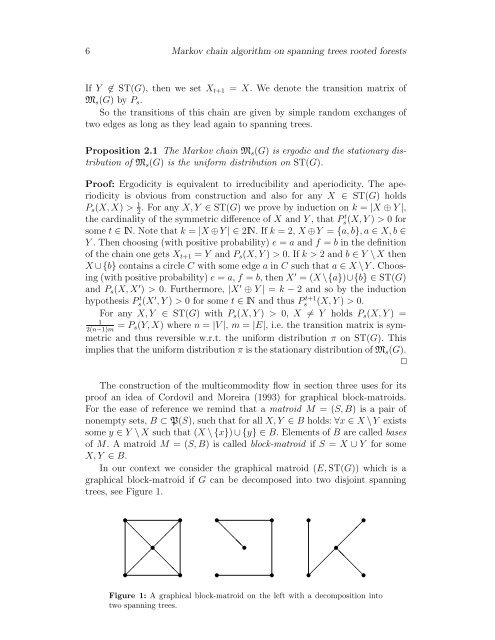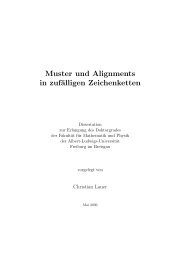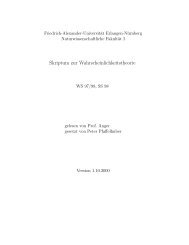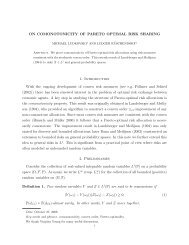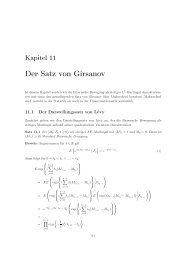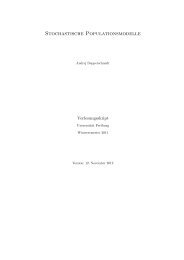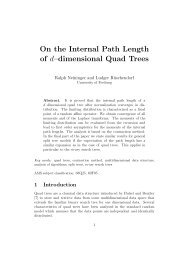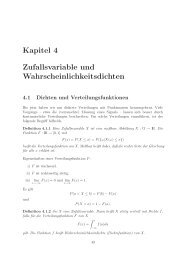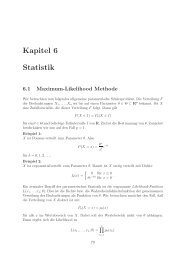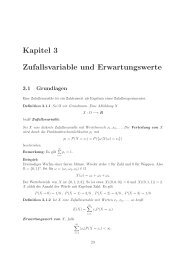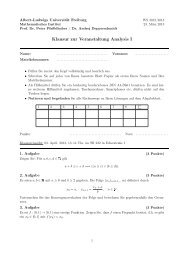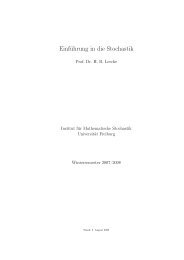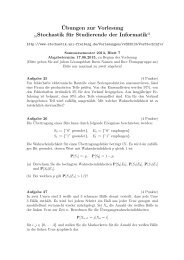Analysis of Markov chain algorithms on spanning trees, rooted ...
Analysis of Markov chain algorithms on spanning trees, rooted ...
Analysis of Markov chain algorithms on spanning trees, rooted ...
Create successful ePaper yourself
Turn your PDF publications into a flip-book with our unique Google optimized e-Paper software.
6 <str<strong>on</strong>g>Markov</str<strong>on</strong>g> <str<strong>on</strong>g>chain</str<strong>on</strong>g> algorithm <strong>on</strong> <strong>spanning</strong> <strong>trees</strong> <strong>rooted</strong> forests<br />
If Y ∉ ST(G), then we set X t+1 = X. We denote the transiti<strong>on</strong> matrix <str<strong>on</strong>g>of</str<strong>on</strong>g><br />
M s (G) by P s .<br />
So the transiti<strong>on</strong>s <str<strong>on</strong>g>of</str<strong>on</strong>g> this <str<strong>on</strong>g>chain</str<strong>on</strong>g> are given by simple random exchanges <str<strong>on</strong>g>of</str<strong>on</strong>g><br />
two edges as l<strong>on</strong>g as they lead again to <strong>spanning</strong> <strong>trees</strong>.<br />
Propositi<strong>on</strong> 2.1 The <str<strong>on</strong>g>Markov</str<strong>on</strong>g> <str<strong>on</strong>g>chain</str<strong>on</strong>g> M s (G) is ergodic and the stati<strong>on</strong>ary distributi<strong>on</strong><br />
<str<strong>on</strong>g>of</str<strong>on</strong>g> M s (G) is the uniform distributi<strong>on</strong> <strong>on</strong> ST(G).<br />
Pro<str<strong>on</strong>g>of</str<strong>on</strong>g>: Ergodicity is equivalent to irreducibility and aperiodicity. The aperiodicity<br />
is obvious from c<strong>on</strong>structi<strong>on</strong> and also for any X ∈ ST(G) holds<br />
P s (X, X) > 1 . For any X, Y ∈ ST(G) we prove by inducti<strong>on</strong> <strong>on</strong> k = |X ⊕ Y |,<br />
2<br />
the cardinality <str<strong>on</strong>g>of</str<strong>on</strong>g> the symmetric difference <str<strong>on</strong>g>of</str<strong>on</strong>g> X and Y , that Ps(X, t Y ) > 0 for<br />
some t ∈ IN. Note that k = |X ⊕ Y | ∈ 2IN. If k = 2, X ⊕ Y = {a, b}, a ∈ X, b ∈<br />
Y . Then choosing (with positive probability) e = a and f = b in the definiti<strong>on</strong><br />
<str<strong>on</strong>g>of</str<strong>on</strong>g> the <str<strong>on</strong>g>chain</str<strong>on</strong>g> <strong>on</strong>e gets X t+1 = Y and P s (X, Y ) > 0. If k > 2 and b ∈ Y \ X then<br />
X ∪{b} c<strong>on</strong>tains a circle C with some edge a in C such that a ∈ X \Y . Choosing<br />
(with positive probability) e = a, f = b, then X ′ = (X \{a})∪{b} ∈ ST(G)<br />
and P s (X, X ′ ) > 0. Furthermore, |X ′ ⊕ Y | = k − 2 and so by the inducti<strong>on</strong><br />
hypothesis Ps(X t ′ , Y ) > 0 for some t ∈ IN and thus Ps t+1 (X, Y ) > 0.<br />
For any X, Y ∈ ST(G) with P s (X, Y ) > 0, X ≠ Y holds P s (X, Y ) =<br />
1<br />
= P 2(n−1)m s(Y, X) where n = |V |, m = |E|, i.e. the transiti<strong>on</strong> matrix is symmetric<br />
and thus reversible w.r.t. the uniform distributi<strong>on</strong> π <strong>on</strong> ST(G). This<br />
implies that the uniform distributi<strong>on</strong> π is the stati<strong>on</strong>ary distributi<strong>on</strong> <str<strong>on</strong>g>of</str<strong>on</strong>g> M s (G).<br />
✷<br />
The c<strong>on</strong>structi<strong>on</strong> <str<strong>on</strong>g>of</str<strong>on</strong>g> the multicommodity flow in secti<strong>on</strong> three uses for its<br />
pro<str<strong>on</strong>g>of</str<strong>on</strong>g> an idea <str<strong>on</strong>g>of</str<strong>on</strong>g> Cordovil and Moreira (1993) for graphical block-matroids.<br />
For the ease <str<strong>on</strong>g>of</str<strong>on</strong>g> reference we remind that a matroid M = (S, B) is a pair <str<strong>on</strong>g>of</str<strong>on</strong>g><br />
n<strong>on</strong>empty sets, B ⊂ P(S), such that for all X, Y ∈ B holds: ∀x ∈ X \ Y exists<br />
some y ∈ Y \ X such that (X \ {x}) ∪ {y} ∈ B. Elements <str<strong>on</strong>g>of</str<strong>on</strong>g> B are called bases<br />
<str<strong>on</strong>g>of</str<strong>on</strong>g> M. A matroid M = (S, B) is called block-matroid if S = X ∪ Y for some<br />
X, Y ∈ B.<br />
In our c<strong>on</strong>text we c<strong>on</strong>sider the graphical matroid (E, ST(G)) which is a<br />
graphical block-matroid if G can be decomposed into two disjoint <strong>spanning</strong><br />
<strong>trees</strong>, see Figure 1.<br />
❅<br />
<br />
<br />
<br />
<br />
<br />
❅<br />
❅ ❅❅❅<br />
❅ <br />
<br />
<br />
❅<br />
❅<br />
❅<br />
<br />
❅ ❅<br />
❅<br />
❅<br />
Figure 1: A graphical block-matroid <strong>on</strong> the left with a decompositi<strong>on</strong> into<br />
two <strong>spanning</strong> <strong>trees</strong>.


